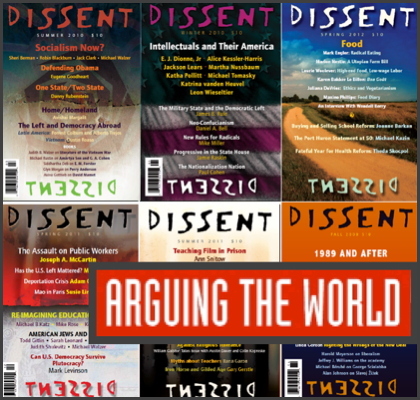A dispatch for the “Arguing the World” blog at Dissent magazine.
Published in Dissent.
As you’ve probably heard, since it has been all over the news, Sarah Palin spoke this past weekend to a group of Tea Party activists at the big kick-off event for a conservative bus tour headed for Washington, DC. Since I have a radio alarm clock, I had the displeasure of gaining consciousness early Sunday morning with reports of this right-wing menace tormenting my not-yet-awake mind.
But once I was alert enough to actually process the facts, the event no longer seemed like such a scary bogeyman. Take a look at the Washington Post’s coverage, which was pretty typical:
“SEARCHLIGHT, NEV.—Sarah Palin urged thousands of “tea party” activists assembled in the dusty Nevada desert Saturday to oust Sen. Harry M. Reid (D), saying he will have to explain his votes in Congress when he returns here to campaign in his home town.
The former Alaska governor assailed the Democrats’ health-care overhaul and told a cheering crowd that Reid, who is fighting for reelection, is “gambling away our future.”….
About 7,000 people streamed into tiny Searchlight, a former mining town 60 miles south of Las Vegas, bringing with them American flags and “Don’t Tread on Me” signs.”
What’s wrong with this picture? Of course, there are lots of things wrong with the Tea Party people. But my problem with the story is this: the numbers. To put it bluntly, 7,000 people is squat. Sure, it’s a lot of folks if they turned out for, say, a local little league game, or if you tried to pack them all inside a McDonald’s. But for a rally that’s treated as a national news story, it’s next to nothing.
What’s more, this number is hardly disputed. The high estimate of attendance at the Tea Party event, the one offered by Fox News, was 9,000. Again: squat.
Let’s take a point of comparison. It just so happens that there was an immigrant rights march in Los Angeles taking place the very same day. Chances are you didn’t hear about it, because it received no national press that I’m aware of. Yet estimates of crowd size ranged from 10,000 to organizers’ estimates of 50,000. At any march or rally, the police tend to issue a low estimate and supporters a higher one. (Norman Mailer, in Armies of the Night if I recall correctly, long ago offered an equation by which you could multiply police numbers, divide the organizer’s estimate, and then split the difference in order to arrive at an accurate prediction of attendance.) But however you count it, the immigrant rights crowd was larger—possibly many times larger—than this weekend’s Tea Party crew.
And consider this: the immigrant rights march in L.A. was a follow-up to a much larger rally which took place a week before in Washington, DC. That one drew as many as 200,000 people. It received a ton of attention in the Spanish-language media, but reaction from mainstream English news sources was notably subdued.
It’s hard not to conclude that the mainstream media, to say nothing of talk radio or cable news, is paying far more attention to the Tea Party activists than their numbers would warrant.
I think this is a trend. The Tea Party “convention” in February in Nashville, which also featured a Palin address, had 600 delegates who stayed for the whole convention, plus another 500 who came just to hear the former Republican candidate for vice president speak. Yet it received excited coverage throughout the national press. To compare: Just two weekends ago, I spent some time at the annual Left Forum in New York City, a conference that considered whether “the hardships and opportunities generated by the capitalist crisis [can] yet become the trigger for the revival of a transformative Left.” Jesse Jackson was the opening speaker, while Noam Chomsky and Arundhati Roy addressed the closing plenary. All indications were that attendance matched or exceeded last year’s forum, which had 3,000 attendees. As for media coverage… umm… let’s just say that the Washington Post didn’t send a reporter.
Here’s another example: In mid-March, during some of the most intense days of the health care debate, Tea Party activists vowed to “flood the halls of Congress” with protesters. But they ultimately produced, at most, 2,000 people. (This was an organizer’s estimate, so divide as appropriate.) For their part, Democratic National Committee members estimated 300 conservative protesters, and DNC Communications Director Brad Woodhouse told Politico’s Ben Smith “I’ve been to birthday parties that drew more people.”
Now, there is some debate among progressives about whether the Tea Party activists are a real grassroots movement to be feared and countered, or whether they are an astro-turfed media phenomenon. Those who contend that we underestimate them at our peril will object to commentators who pooh-pooh low Tea-Party turnout. In my view, their call to take the conservative populists seriously is not without some merit. I believe that right-wingers have done far better than the left at capitalizing on and channeling diffuse popular dissatisfaction with the economic crisis into organized resistance. To that extent, I agree that Tea Party activism is something to be reckoned with.
At the same time, there also seems to me to be a great deal of echo chambering going on, with news organizations taking their cue from Fox News. This is amplifying the message far more than it deserves to be, based on the actual constituency the Tea Party folks have demonstrated. Some years ago I wrote a piece entitled “Those Who Don’t Count“ about the military and the media’s disinterest in counting civilian casualties in Iraq. I think this one, in contrast, might be written up as a case of “Those who count an awful lot.”
